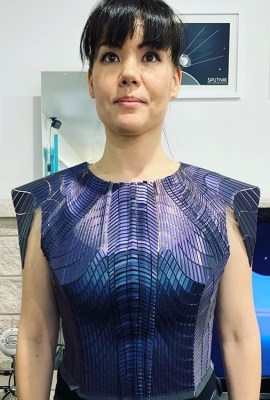For many of us, the term “wearable technology” conjures up mental images of the Borg from Star Trek: harsh mechanical shapes and exposed wiring grafted haphazardly onto a human form that’s left with a range of motion just north of the pre-oilcan Tin Man. It’s simply a projection of the sort of hardware we’re used to. Hacker projects are more often than not a mass of wires and PCBs held in check with the liberal application of hot glue, with little in the way of what could be called organic design. That might be fine when you’re building a bench power supply, but unfortunately there are not many right angles to be found on the human body.
Thankfully, we have designers like Sophy Wong. Despite using tools and software that most of us would associate with mechanical design, her artistic eye and knowledge of fashion helps her create flexible components that conform to the natural contours of the wearer’s body. Anyone can take an existing piece of hardware and strap it to a person’s arm, but her creations are designed to fit like a tailored piece of clothing; a necessary evolution if wearable technology is ever going to progress past high-tech wrist watches.
During her talk “Made With Machines: 3D Printing & Laser Cutting for Wearable Electronics” at the 2019 Hackaday Superconference in Pasadena, Sophy walked attendees through the design process that she’s honed over years of working on wearable creations. Her designs start in the physical world, occasionally taking the form of sketches drawn directly onto the surface of whatever she’s working on, before being digitized and reproduced.
Featuring graceful curves and tessellated patterns that create a complex and undeniably futuristic look, many of her pieces would be exceptionally difficult to create without modern additive or subtractive manufacturing methods. But even still, Sophy explains that 3D printers and laser cutters aren’t magic; these machines free us from time consuming repetitive tasks, but the skill and effort necessary to create the design files they require are far from trivial.
Expectation vs Reality
Early in her talk, Sophy compares her experience with 3D printers and laser cutters to a tool that’s perhaps a bit less commonly seen in the workshop of the average Hackaday Supercon attendee: a sewing machine. She explains that when she first got her sewing machine, she imagined herself sitting down and powering through projects with ease. But in reality, the majority of her time ended up being spent on design and preparation. When she finally was ready to use the sewing machine, the project was already in the home stretch.
In the same way, she says new 3D printer or laser cutter owners need to understand that there’s a considerable amount of work to be done before you’re able to just push a button and receive your final product. For as much physical labor these machines save, they add an equal amount (if not …read more
Source:: Hackaday

